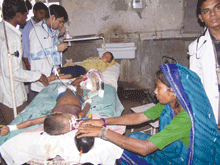Every year during the monsoon season (June-September), several hund- red children in Uttar Pradesh (pop. 166 million) fall prey to the fatal Japanese Encephalitis (JE) virus. This is par for the course in UP where of the 5.4 million children born every year, 275,000 die within 30 days of birth and 450,000 before their first birthday. This year the vector borne JE virus has already claimed more than 200 lives of children under age 15, even as an ambitious vaccination programme has been suspended following a spat between the state and Central governments.
 The JE virus, which is transmitted to humans by mosquitoes breeding in stagnant water and causes high fever, vomiting, coma and eventual death, has snuffed out the lives of children in this under-developed Hindi heartland state (literacy: 56.27 percent; per capita income: Rs.11,856 per year) for many years. But in 2005, the issue was pushed to centrestage when JE felled more than 1,500 children. (Adults are rarely affected as they develop immunity due to earlier exposure to the JE virus). Therefore in 2006 the state government launched a massive vaccination programme which resulted in a sharp drop in the number of casualties.
The JE virus, which is transmitted to humans by mosquitoes breeding in stagnant water and causes high fever, vomiting, coma and eventual death, has snuffed out the lives of children in this under-developed Hindi heartland state (literacy: 56.27 percent; per capita income: Rs.11,856 per year) for many years. But in 2005, the issue was pushed to centrestage when JE felled more than 1,500 children. (Adults are rarely affected as they develop immunity due to earlier exposure to the JE virus). Therefore in 2006 the state government launched a massive vaccination programme which resulted in a sharp drop in the number of casualties.
But with 400 deaths reported in 2007, mostly from the 18 eastern districts of the state (Gorakhpur, Basti, Maharajganj, Siddharthnagar, Sant Kabir Nagar, Kushinagar and Bahraich were the worst affected), the state government made elaborate plans to tighten its immunisation programme to contain the virus this year. However the vaccines arrived in Lucknow on September 11, not only too late and inadequate, but also unfit for use. When samples from the consignment, valued at Rs.2 crore were put through vaccine vial monitors, they changed colour, indicating loss of potency.
According to media reports in Lucknow, the first batch of vaccines had been left unattended at Lucknow’s Amausi airport for five hours and consequently had suffered a cold chain break down. But the state government’s health minister Anant Mishra laid the blame on the doorstep of the Central government. “We had demanded 1 million vaccine units but received only 450,000. It is because of the Centre that we are suffering. Yet the Central government condemns us for the poor state of our public health,” says Mishra adding that New Delhi is to blame for delaying the start of the immunisation drive which was to kick off in July.
The Central government responded by sending a two member team on September 17 to probe the allegation. After samples of the vaccine had been drawn for testing, all that team leader Anil Kumar, assistant commissioner, department of health and director of the Centre’s immunisation programme, was willing to say was: “At this stage it is hard to hold anyone responsible. We shall know only after a lab report.” The report is still awaited, as is a fresh supply of vaccines.
Unsurprisingly a war of words has broken out between New Delhi and the UP government. The state government’s director general, family welfare, M.L. Khatloiya is unwilling to commit to a date as to when the immunisation programme will resume. “We cannot say anything about when the vaccination drive will re-start,” he told media personnel on September 16.
Meanwhile the Congress-led UPA government in Delhi, which has little love for the BSP government led by fiery woman chief minister Mayawati, has sent a stinker to the state government charging it with over-reporting coverage and inflating its vaccines requirement. “The recently conducted DLHS-3 survey has shown that the actual coverage of children receiving full immunisation is only 30.3 percent, whereas the Uttar Pradesh government has reported it around 95 percent,” says a letter dated September 20 signed by Union health secretary Naresh Dayal.
The state government’s principal secretary (medical health), Neeta Chaudhary alleges strong Central government bias against BSP-ruled UP. “Even a smaller state like Maharastra gets a better deal. Our demands go unheeded in Delhi,” she complains.
Chaudhary’s grouse is backed by Union health ministry data, according to which Congress-led Maharashtra with its population of 97 million has 1,100 ice lined refrigerators and 1,555 deep freezers compared to UP’s 452 and 755 respectively. This despite the number of children requiring immunisation in UP being 5.46 million against Maharashtra’s 1.88 million.
In this war of words, no one seems to be paying attention to the 1,000-plus children who have so far been diagnosed with acute infections. But then children who can’t vote never figure high on the list of priorities of the Central or state governments.
Vidya Pandit (Lucknow)